Your old friends . . . where are they now?
On this page: From the last 10 years - Roger Gaertner, Rebecca Danard, Solange Courteau, Katherine Kitching, William Godsoe, and Eric Smith
Roger Gaertner, 1980s and '90s
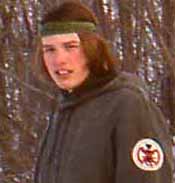 Roger was an active Macoun member from the mid-1980s through the mid-1990s. He was usually President or Vice-President of his group, and became Editor of both the Newsletter and the Little Bear. In 1995, he won the Macoun Club's Baldwin Scholarship.
Roger was an active Macoun member from the mid-1980s through the mid-1990s. He was usually President or Vice-President of his group, and became Editor of both the Newsletter and the Little Bear. In 1995, he won the Macoun Club's Baldwin Scholarship.
When he was 17, Roger participated in the Junior Rangers program. That led into four summers working in Ontario's parks, including Sandbanks Provincial Park, and as head of the National Heritage Education department at Kettle Lakes Provincial Park near Timmins.
After finishing his Honours Bachelor of Science in Biology at McMaster University, Roger moved to Paris, France, to pursue graduate studies in medical biology. He received his PhD in Cardiovascular Physiology in 2004 and has worked as a pharmacology scientist for Servier Pharmaceuticals in their angiology division.
And he's still looking for something other than a crow, pigeon, or magpie out of his apartment window overlooking the Eiffel tower ....
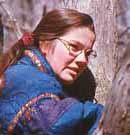 Rebecca joined the Macoun Club in 1987, and right away discovered the fun of field trips, rain or shine (caught puffing puffballs with Solange, below right). After a few years, she was always President or Vice-President of her group. And she was sure to be on every camping trip -- snowshoeing, swimming, squelching in the mud.
Rebecca joined the Macoun Club in 1987, and right away discovered the fun of field trips, rain or shine (caught puffing puffballs with Solange, below right). After a few years, she was always President or Vice-President of her group. And she was sure to be on every camping trip -- snowshoeing, swimming, squelching in the mud.
For a Study Area project, Rebecca took on a whole slice of time, from the end of the Champlain Sea 10,000 years ago down to the present. Under the guidance of former Macoun Club leader Paul Hamilton, in the Museum of Nature, she detailed the changing character of a pond's diatom populations, which had been preserved in a peat bed.
The experience of working with a microscope in the Museum determined her to purchase an excellent instrument of her own. One of the first things she looked at -- "after diatoms of course" -- was a lichen.
The discovery of diatoms, an expensive microscope . . . where would they lead?
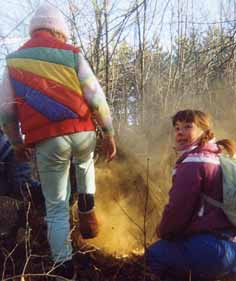 At the University of Western Ontario, Rebecca decided on an unusual combination of studies, and we are sure she's had to explain it many times: music, and microbiology.
At the University of Western Ontario, Rebecca decided on an unusual combination of studies, and we are sure she's had to explain it many times: music, and microbiology.
After a slight shift in focus, she spent two summers working on benthic macroinvertebrates -- the bugs that live at the bottom of streams. She graduated a year ago with two degrees: a B. Mus. in Clarinet Performance, and a B.Sc. in Ecology and Evolution (she won the gold medal for the latter!)
In the summer of 2003 she worked for the huge GLEI (Great Lakes Environmental Indicators) project. It involved sampling all forms of life from birds to benthos, first along the shoreline east of Chicago, and then (because their bigger boat gave out) in swamps.
She returned to Ottawa for the summer of 2004, and was working for Paul Hamilton, determining the distribution of the invasive Eurasian Watermilfoil in the Rideau Canal. "This involved some field work along the canal, lots of research, and the writing of the longest thing
I've ever done (over 140 pages!)"
In 2005 she was doing a Master's in clarinet performance at the University
of Cincinnati College Conservatory of Music.
Solange Courteau, of the 1990s
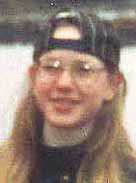 Solange was a member from 1988 to 1998. She was a regular on every field trip and camping trip for years, and always seemed to come to prominence through her unfailing interest in nature, and her unique perspective on the world.
Solange was a member from 1988 to 1998. She was a regular on every field trip and camping trip for years, and always seemed to come to prominence through her unfailing interest in nature, and her unique perspective on the world.
At right and above, Solange and Rebecca making a smoke of puffball spores, Nov. 17, 1990.
After leaving Macoun Club, Solange attended a college in India and worked on a local newspaper there. "Indian cities," she discovered, "are as much for the animals as the people. There isn't the distinct separation between nature and human habitation that we have in Canada. There are mice, birds, bats . . . cockroaches, lizards and moths in every home. Vines grow in through the windows. In Nagpur (2.3 million people) I have also seen water buffalo, donkeys, elephants, camels, ponies, boars, more dogs than people, domestic and holy cows, rats (so huge I thought they were rabbits!), mongooses, and frogs (not many)."
"Oh, and two kinds of monkeys, red-faced and black-faced ones, all with extremely long tails. They move in big groups around the city."
After returning to Canada, Solange spent the spring and summer of 2001 crossing much of the country by bicycle, eventually fetching up in Ottawa. "Cycling up mountains, down valleys, through the Okanogan, the northern prairies, across watersheds and rivers, made Canadian geography so real and interesting."
Now she is living in Mexico. "In this desert-like part of Chiapas," she says, "the trees bloom in a strange and wonderful way. Every season has a different colour. At Christmas, for example, the landscape was brown and dry, but there were enormous trees full of flowers as yellow as the yellowest tulip you've ever seen. They looked painted against the white-hot sky."
"In the spring time, all the flowers are pink and purple! They range from very pale to violet and most of the flowers are fleshy. The acacia trees are also in bloom, and they perfume the night like the jasmine in India did. Each flower is on a long (10cm) stalk and has a green and yellow ball of fluff at the end, like something from a Dr. Zeus book. On the tree, the ball of fluff has a very fine pink hairdo, which isn't there when I pick up the stalk off the ground."
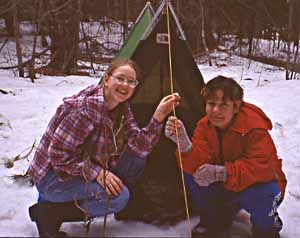
Katherine came to the Macoun Club just a little late, and could only stay with us for seven years, from 1991 to 1998, but she so filled that time with fun and adventure that the whole period looms large in the memory.
She was Secretary for five years, Vice President for one, and President of the Seniors in her last year. She produced elaborately decorated newsletters month after month for years, and with a gift for gentle caricature, she contributed a number of humorous cartoons featuring her fellow members and the leaders. In some years, her prolific articles dominated our Little Bear magazine, and they now provide a detailed record of our many field trips, including some of the most misadventurous. Year after year, she organized the richest assortment of foods imaginable for our camping trips.
In 1999, one year out of Macoun Club, she headed for British Columbia for three weeks with her best friend, Nicky. "We saw tide pools swimming with life, vast empty Pacific beaches littered with sun-bleached logs, and deep, dark, west-coast rainforest, full of strange mossy caves under massive green feathery ferns and glistening liverworts, and a cool, slimy wetness that rested on everything, and seemed oppressive after the dry, windy pines of Pakenham. I could go on forever about that forest," she says: "the smell -- heavy with rot and rejuvenation, the closeness that you felt as the lichen-hung, leafy branches pressed in around you, and the cedars -- so large and thick and silent that one forgot they were trees and began to worship them as separate entities -- mothers and guardians of the sacred, age-old forest."
For three summers, she worked in the naturalist programs in some of Ontario's provincial parks (Algonquin, and Murphy's Point Prov. Pks.) Then, in the summer of 2003, she and Nicky went off to the Yukon, a frontier land of great rivers and mountains, forests, and tundra. Curiously, she found her favourite place just outside the Territory, in Atlin, B.C. Canoeing there, they rode out some rough weather on a most wonderful lake, and when the winds had passed, found that the water became as still as a sheet of ice. "It had turned a milky silver colour," she says. "It was the most incredible scene I've ever laid eyes on, sparkling and shining in a way I couldn't have dreamed possible, with ranges of mountains fading away into the distance, each a slightly lighter and more delicate shade of blue than the one before."
In 2004, she retuned to the parks program, working in Samuel de Champlain Provincial Park, and in the autumn began her fourth year of Arts & Sciences studies at McMaster University.
Here we see Solange and Katherine setting up their tent at Pakenham.
William Godsoe, 1990s
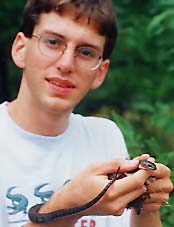
William came into the Macoun Club already familiar with snakes and frogs on a scientific-name basis. Gradually other interests emerged: among them fossils, birds, and insects. In the days before photographic keys on the internet made such things easy, he could catch an early mosquito and a day later tell us what species it was. If the creature had an English name, he could generally tell us that, too. Here he is shown with a Black Rat Snake at Murphy's Point Provincial Park.
Although William has graduated from school and left Macoun Club, he sometimes comes back for a day and then we see how these skills are employed with exceptional enthusiasm and delight.
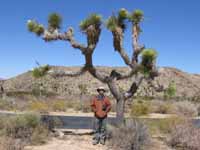 William studied biology at the University of Guelph. Starting in the last years of his time with the Club, he worked summers in Algonquin Park's naturalist program.
William studied biology at the University of Guelph. Starting in the last years of his time with the Club, he worked summers in Algonquin Park's naturalist program.
Every Macouner these days has a Study Tree, but while pursuing a Ph.D. in the American southwest, William had a whole Study-Tree-Species, the Joshua "Tree". Its interactions with Yucca Moths seem to have led to a series of studies on ecology and evolution.
Eric Smith, early 2000s
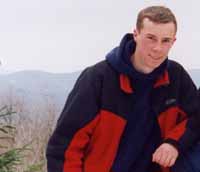
Eric came into Macoun Club with an enthusiasm for nature that seemed only to grow while he was with us. As if to make up for already being so close to graduating from high school when he joined, he participated in the field trips of both Juniors and Seniors. And if he couldn't induce his fellow Macouners to go with him, he'd explore the Study Area on his own, binoculars at the ready. In his last year, he was President of the Senior group.
Leaving Ottawa, he went to work at Bon Echo Provincial Park for the summer. "I worked as a Natural Heritage Educator," he says. "I created and led a children's program and guided hikes. I never knew what we were going to see, and I had to be ready for anything. It was great to live in the park, falling to sleep to the calls of the bullfrogs and loons."
After finishing work he hurried off to college in Sault Ste. Marie. "All the profs I have met are so awesome and animated," he reported in the first few weeks. "I can barely hold my excitement for learning -- I have been working almost constantly on two collecting assignments -- leaves and insects."
In the summer of 2004, Eric worked for Ducks Unlimited in North Dakota. "It was great to be paid to walk around and watch wildlife," he wrote; "I just wish I was not so rushed to get it all done" He had 60 nests to check up on that day, and one of the Short-eared Owls would not leave her eggs. He practically had to stand right over her. "It was awesome to see this creature so close. She stared at my every move, not willing to leave her nest. I did not want to disturb her but I had to count those eggs. At last she flushed from the nest. I watched her fly with such grace and majesty."
Eric has finished his second year at Sault College and has returned to Ducks Unlimited. "Cattle, cowboys, sunsets of all colours and textures, breeding birds, friendliness, and fun. Being outside everyday immersed in nature is wonderful!"
Return to Top.
Check out other memories
All photos donated or provided by members and leaders, past and present. Updated in part July 16, 2006 and July 14, 2010.
 Roger was an active Macoun member from the mid-1980s through the mid-1990s. He was usually President or Vice-President of his group, and became Editor of both the Newsletter and the Little Bear. In 1995, he won the Macoun Club's Baldwin Scholarship.
Roger was an active Macoun member from the mid-1980s through the mid-1990s. He was usually President or Vice-President of his group, and became Editor of both the Newsletter and the Little Bear. In 1995, he won the Macoun Club's Baldwin Scholarship. Rebecca joined the Macoun Club in 1987, and right away discovered the fun of field trips, rain or shine (caught puffing puffballs with Solange, below right). After a few years, she was always President or Vice-President of her group. And she was sure to be on every camping trip -- snowshoeing, swimming, squelching in the mud.
Rebecca joined the Macoun Club in 1987, and right away discovered the fun of field trips, rain or shine (caught puffing puffballs with Solange, below right). After a few years, she was always President or Vice-President of her group. And she was sure to be on every camping trip -- snowshoeing, swimming, squelching in the mud. At the University of Western Ontario, Rebecca decided on an unusual combination of studies, and we are sure she's had to explain it many times: music, and microbiology.
At the University of Western Ontario, Rebecca decided on an unusual combination of studies, and we are sure she's had to explain it many times: music, and microbiology. Solange was a member from 1988 to 1998. She was a regular on every field trip and camping trip for years, and always seemed to come to prominence through her unfailing interest in nature, and her unique perspective on the world.
Solange was a member from 1988 to 1998. She was a regular on every field trip and camping trip for years, and always seemed to come to prominence through her unfailing interest in nature, and her unique perspective on the world.

 William studied biology at the University of Guelph. Starting in the last years of his time with the Club, he worked summers in Algonquin Park's naturalist program.
William studied biology at the University of Guelph. Starting in the last years of his time with the Club, he worked summers in Algonquin Park's naturalist program.